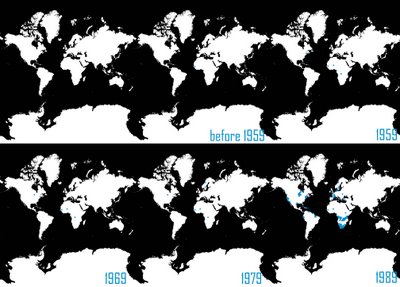BACKGROUND
AIDS (Acquired Immune Deficiency Syndrome), caused by the HIV virus, is theorized to have originated in the species of chimpanzee known as the sooty mangabey, which mainly inhabit the region of Guinea-Bissau. In 1959, the two earliest known cases were recorded - the first one in the Belgian Congo, and the second in Manhattan. Cases were very sporadically diagnosed, steadily increasing in number and location over the next 25 years, adn then had a spike in the 1980s. Originally thought to have been related to homosexual sex, it was called GRID (Gay-Related Immune Deficiency) until 1982, when it was decided that the number of cases found in heterosexual women disproved that theory. Today, there are anywhere from 33.4 million - 46.0 million people living with the HIV virus.
The data available contains some level of error. Before the late 1980s, doctors were not educated on the symptoms of AIDS and it was still thought to be new to the United States. For these reasons, diagnoses were rare and the disease was still not widespread. Later on, scientists examined remains of people who had died of similar symptoms in the 1960s and 1970s, and found that as a general rule, AIDS was not widespread and these people had not been misdiagnosed in their lifetimes. Therefore, scientists and doctors believe that the sudden growth of AIDS in the 1980s was not due to a raised awareness in the medical field, but does serve as a fairly accurate judge of the spread of the actual disease.
(click for larger view)

APPROACH
As you can see from the images displayed, I am working on compiling the data of the simple area spread of the disease, and I will show that in one or a series of flash animations. What will occur three-dimensionally will be done in FormZ, and that will include the data of population infected numbers in regions. The reason is that I want to show simply the spread of infection across the continents without regards to population statistics. The
three-dimensional map will show the problem areas, areas where the disease has most successfully infiltrated the population.
(click images for a larger view)



PURPOSE
I believe that this data can be useful conceptually as a visual display of the disease's spread across the globe. AIDS, like global warming and radiation, spreads rapidly and widely, being passed from person to person. I will express the areas of the Earth in which the disease is present during given periods of its development and spread, and I will also express the differences in population infection. The mappings will display the fact that the area where AIDS is the most prevalent is sub-Saharan Africa and least prevalent is Southeast Asia, for example. I hope that these mappings could give a good visual of exactly what it means for the world to be at the mercy of a pandemic, and a graphic understanding of the parts of the world that need help the most.


No comments:
Post a Comment